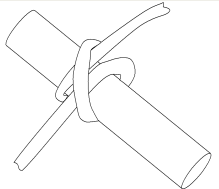Clove hitch
|
|
The clove hitch is a type of knot. It is one of a number of knots known as binding knots. It has been in use since ancient times.
Canonical Name: Clove hitch
Variant Name(s): None.
Category: hitch
Origin: Ancient
Related Knots: hitch knots, constrictor knot, lashings.
Releasing: Jamming.
Efficiency: Unknown.
Caveat: May slip. This knot requires a load in each direction in order to be effective. It should not be relied on with rope that is thin or very slippery, as it can work itself loose, especially under a swinging or rotating load. It can also jam and become difficult to untie under some situations.
Uses: The clove hitch is normally used for securing objects, such as tying a load on a trailer or truck as a means of reliably securing one end of the rope, especially when used in combination with a sheepshank to ensure tension is maintained. The clove hitch is the starting knot in most lashing knots. It is very fast to tie and easy to adjust the knot for length, making it useful at belay stations in rock climbing, where the belayer can maintain the necessary tension.
Structure: It is formed from two half hitches around a rail or post where one is reversed or opposed to the other. This opposition causes the knot to grip against itself when tension is applied. It can be pre-formed in the middle of the rope, then slid over the end of a post.
Tying: Begin by forming a loop around the pole, with the working end of the rope on top. Run the working end round the pole once more until you meet the place where the ropes cross, then pass the working end under the cross. Pull to tighten.
See also
External links
- Grog's Animated Knots: How to tie the clove hitch (http://www.grogono.com/knot/clove/index.php?LogoImage=LogoGrog.jpg)
- Notable Knot Index (http://www.geocities.com/roo_two/clovehitch.html) - shows quick method of tying
- Hitch Knots (http://www.realknots.com/knots/hitches.htm) - including instructions

